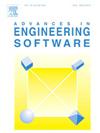Inverse design of multiband higher-order elastic topological insulators via generative deep learning
IF 5.7
2区 工程技术
Q2 COMPUTER SCIENCE, INTERDISCIPLINARY APPLICATIONS
引用次数: 0
Abstract
Higher-order elastic topological insulators with corner states exhibit significant potential for robust elastic wave localization. Nevertheless, it is quite challenging to design multiband topological structures on demand via traditional empirical methods that rely on trial and error. Here, we present a novel inverse design paradigm for multiband higher-order elastic topological insulators based on deep learning techniques. A generative model that enables a vast design space is first developed, incorporating a rich series of unit cell patterns with the desired crystalline symmetry and fabrication feasibility. Thereafter, a predictive model is constructed to efficiently forecast the dispersion characteristics of any given unit cell, thereby accelerating the discovery of potential multiband topological structures. We demonstrate the effectiveness and reusability of the proposed design framework through diverse examples of multiband higher-order elastic topological insulators with multi-frequency corner states. This deep learning-driven approach addresses the limitations of conventional inverse design methods, which often require computationally expensive simulations and lack flexibility to variable design tasks. Our work underscores great potential of deep learning techniques for the inverse design of high-performance topological metamaterials.
基于生成深度学习的多频带高阶弹性拓扑绝缘子逆设计
具有角态的高阶弹性拓扑绝缘子具有鲁棒弹性波局域化的显著潜力。然而,通过传统的依赖于试错的经验方法根据需求设计多带拓扑结构是相当具有挑战性的。在此,我们提出了一种基于深度学习技术的多波段高阶弹性拓扑绝缘体的反设计范式。首先开发了一个生成模型,可以实现巨大的设计空间,将丰富的一系列单元格图案与所需的晶体对称性和制造可行性结合起来。然后,构建预测模型,有效地预测任意给定单元的色散特性,从而加速发现潜在的多带拓扑结构。我们通过具有多频率角态的多频带高阶弹性拓扑绝缘子的不同示例证明了所提出的设计框架的有效性和可重用性。这种深度学习驱动的方法解决了传统逆向设计方法的局限性,这些方法通常需要计算昂贵的模拟,并且缺乏对可变设计任务的灵活性。我们的工作强调了深度学习技术在高性能拓扑超材料逆设计方面的巨大潜力。
本文章由计算机程序翻译,如有差异,请以英文原文为准。
求助全文
约1分钟内获得全文
求助全文
来源期刊

Advances in Engineering Software
工程技术-计算机:跨学科应用
CiteScore
7.70
自引率
4.20%
发文量
169
审稿时长
37 days
期刊介绍:
The objective of this journal is to communicate recent and projected advances in computer-based engineering techniques. The fields covered include mechanical, aerospace, civil and environmental engineering, with an emphasis on research and development leading to practical problem-solving.
The scope of the journal includes:
• Innovative computational strategies and numerical algorithms for large-scale engineering problems
• Analysis and simulation techniques and systems
• Model and mesh generation
• Control of the accuracy, stability and efficiency of computational process
• Exploitation of new computing environments (eg distributed hetergeneous and collaborative computing)
• Advanced visualization techniques, virtual environments and prototyping
• Applications of AI, knowledge-based systems, computational intelligence, including fuzzy logic, neural networks and evolutionary computations
• Application of object-oriented technology to engineering problems
• Intelligent human computer interfaces
• Design automation, multidisciplinary design and optimization
• CAD, CAE and integrated process and product development systems
• Quality and reliability.
 求助内容:
求助内容: 应助结果提醒方式:
应助结果提醒方式:


